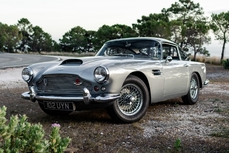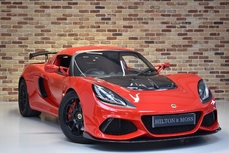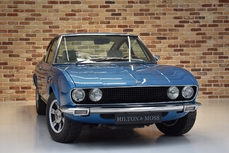Aston Martin DB4 Series 2 Nut and Bolt Restoration 1960
General description :
This particular DB4 Series 2 is on the market with the previous owner, Mr D Banton, having bought the car in December of 1976 and has just undergone a complete restoration through ourselves.
DB4/449/R was first registered on the 17th November 1960 where it was sold to a Mrs N Cotton of Bournemouth, then sold to a Mr S Dicks of London in 1965, whereupon it was sold to Mr Richard Butt of Grays who subsequently sold it to his brother, a Mr (Roger) Butt who kept the car until 1976.
Mr D Banton used the car regularly in and around London and perhaps more fitting for a car of this style, slightly further afield with trips across Europe to the French Alps for skiing holidays.
In 1983 Mr D Banton sent the car for a full bare metal respray, keeping the original colour of Dubonnet Red. Other work includes receipts in the history file dating back to 1976 with hand written invoices from Ian Moss, Aston Martin specialists. Further maintenance was carried out in the late 70’s with bills from Aston Martin and Aston specialist Hyde Vale and later in 1996 with Ian Moss once again. Also in the history file is a copy of the buff log book, handbook and a copy of the original invoice from 1960.
The DB4 was a true sports car to the DB5’s Sports GT, and the values are continuing to increase in line with all classic Aston values. The Series 2 cars had some minor modifications over the original design including a front hinged bonnet (rather than the “crocodile” bonnet of the Series 1), uprated front calipers and oil pump and an enlarged sump.
Fresh from a full nut and bolt restoration, the car has had a full bare metal respray in Silver Birch, finished with black leather interior. Oselli have rebuilt the engine to 4.2 litre specification with unleaded fuel conversion, whilst lightening and balancing the engine and fitting Cosworth forged pistons. The 4 speed David Brown gearbox has been rebuilt and overdrive fitted. Electric power steering has been retrofitted, in addition to a heated rear windscreen, electronic clock, electric aerial and retro-look radio with iPod connection. It has new wire wheels with period correct Avon Turbosteel tyres, and a larger anti-roll bar to improve cornering and lessen body roll. The car has also had an oil cooler and Kenlowe electric fan installed.
A fantastic opportunity to obtain one of the very best Series 2 DB4s on the market today.
For any serious enquiries, please ring Fraser on 01279 813907/07880 554460.
http://hiltonandmoss.com/cars/aston-martin-db4-series-2-nut-and-bolt-restoration-for-sale/
1960 Aston Martin DB4 Series 2 Nut and Bolt Restoration is listed sold on ClassicDigest in Stansted by Hilton Moss for £675000.
Car Facts
Car type : Car Make : Aston Martin Model : DB4 Model Version : Series 2 Nut and Bolt Restoration Engine size : 4.2 Model Year : 1960 Location : Stansted
Sold
Seller Information
Sold
People who viewed this Aston Martin DB4 also viewed similar Aston Martin listed at ClassicDigest
Other cars listed for sale by this dealer
About Aston Martin DB4
The Aston Martin DB4 is an iconic model in Aston Martin's history, known for its elegant design, performance, and luxury. Here's an overview of its history, specifications, production numbers, and cultural context:1. History: The Aston Martin DB4 was introduced in 1958 as a replacement for the DB Mark III. It was designed by Carrozzeria Touring of Milan, Italy, and represented a significant step forward for Aston Martin in terms of performance and styling.
2. Specifications:
- Engine: The DB4 initially featured a 3.7-liter inline-six engine, which was later upgraded to a 4.0-liter engine in later models. The power output ranges from approximately 240 to 266 horsepower, depending on the specific variant.
- Transmission: It was equipped with a 4-speed manual transmission, and some later models were offered with a 3-speed automatic transmission as an option.
- Performance: The DB4 was capable of achieving a top speed of around 140 to 150 mph (225 to 240 km/h) and could accelerate from 0 to 60 mph (0 to 97 km/h) in approximately 8 seconds.
3. Production Numbers: The production numbers for the Aston Martin DB4 are as follows:
- Aston Martin DB4 (1958-1963): Approximately 1,113 units produced across various body styles and variants.
4. Cultural Context: The Aston Martin DB4 represented a significant leap forward for Aston Martin in terms of design and performance. It showcased a blend of British craftsmanship and Italian styling, incorporating lightweight construction techniques and elegant lines. The DB4's luxurious and sporty character made it a desirable choice for discerning buyers, including celebrities and enthusiasts.
The DB4's success on the road and its participation in motorsport events further enhanced its reputation. It competed in various racing and rallying events, achieving notable successes, including class wins and overall victories in races such as the Le Mans 24 Hours and the RAC Tourist Trophy.
The Aston Martin DB4 remains an iconic and highly sought-after classic car today. Its timeless design, powerful performance, and connection to Aston Martin's heritage have made it a symbol of automotive excellence and desirability. Collectors and enthusiasts value the DB4 for its rarity, craftsmanship, and historical significance within the Aston Martin lineup.
"Superleggera" is an Italian term meaning "super light" or "super lightweight." It is often associated with the coachbuilding company Carrozzeria Touring Superleggera, which has been known for its lightweight construction techniques used in the creation of various iconic automobiles.
Carrozzeria Touring Superleggera is credited with popularizing the superleggera construction method, which involved using a lightweight framework of small-diameter steel tubes covered with hand-formed aluminum panels. This construction technique reduced the overall weight of the vehicle while maintaining structural integrity.
The term "Superleggera" has also been used by several automakers, including Aston Martin, Lamborghini, and others, to denote special lightweight or high-performance versions of their vehicles. These vehicles often feature weight reduction measures, aerodynamic enhancements, and increased power output to deliver enhanced performance and driving dynamics.
For example, Aston Martin has used the "Superleggera" designation on models such as the Aston Martin DBS Superleggera, which represents the ultimate expression of performance and luxury in the Aston Martin lineup. These vehicles typically feature powerful engines, advanced aerodynamics, and extensive use of lightweight materials to achieve a perfect balance between performance and luxury.
In summary, "Superleggera" refers to the concept of lightweight construction and has been associated with both the Carrozzeria Touring Superleggera coachbuilder and specific high-performance models from various automakers. It represents a pursuit of weight reduction and improved performance without compromising on style and luxury.








